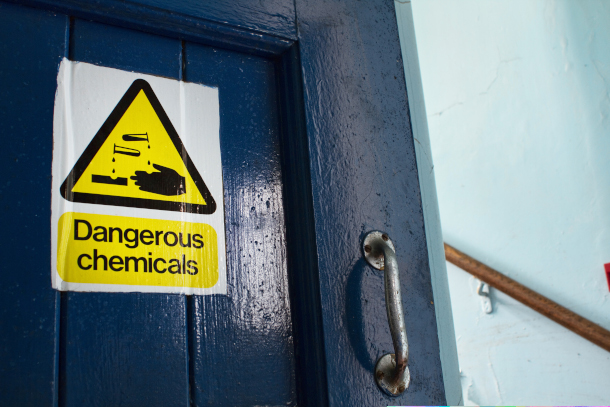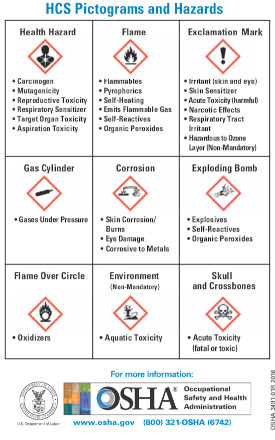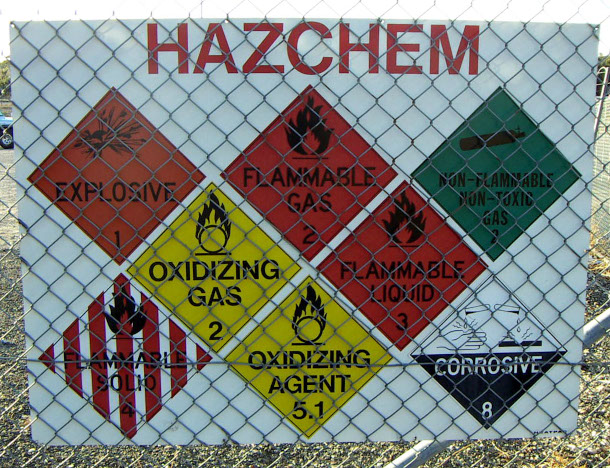Workers Left in the Dark About Chemical Risks
Air Date: Week of February 24, 2023

A recent study of 650 Safety Data Sheets found that thirty percent contained inaccurate hazard warnings. (Photo: Tom Blackwell, Flickr, CC BY-NC 2.0)
Safety Data Sheets provide information about the risks of workplace chemicals. Recent research found that nearly a third of those studied contained inaccurate hazard warnings and often downplayed the risks of known carcinogens. Charlotte Brody, the Vice President of Health Initiatives for Blue Green Alliance, which co-produced the study, joins Host Bobby Bascomb to discuss why the failure to disclose these risks undermines worker safety.
Transcript
BASCOMB: It’s Living on Earth, I’m Bobby Bascomb.
The Occupational Safety and Health Administration, or OSHA, requires that employers must make information about workplace chemicals available to their workers in the form of Safety Data Sheets. But a recent study of 650 Safety Data Sheets found that nearly a third of them contained inaccurate hazard warnings, often downplaying the risk associated with chemical exposure. For example, Vinyl Chloride, is the same chemical released from the derailed train in Ohio that we talked about earlier in the show. It’s a known human carcinogen but the safety data sheets used for many products containing vinyl chloride only mentioned skin, eye, and respiratory irritation. A full fifteen percent of the products containing cancer-causing chemicals failed to warn of cancer as a risk on their safety data sheets. Workers are often exposed to hazardous chemicals in products like cleaning solvents, paints, and lubricants and Charlotte Brody says failure to disclose that risk undermines worker safety. Charlotte is the Vice President of Health Initiatives for Blue Green Alliance, which co-produced the recent study. Charlotte, welcome to Living on Earth!
BRODY: Thank you.
BASCOMB: So what exactly were you looking to learn with this report? And what prompted the investigation?

Employers are required to provide their workers with information about the hazards of workplace chemicals in the form of Safety Data Sheets. (Photo: OSHA.gov)
BRODY: Safety Data Sheets are the fundamental piece of information that every workplace and every worker is supposed to have access to, that tell them if a chemical is dangerous, so that they can protect themselves and work with their employer maybe to find a safer product to use. If the information on this fundamental basis of all hazard communication isn't accurate, the whole idea of how to protect workers from dangerous chemicals falls apart. And that's why we wanted to do this study. There were two studies in the literature, both very small, that showed the inaccuracy of Safety Data Sheets, and the challenge we set out for ourselves is to see if you could automate the process of reviewing Safety Data Sheets and seeing if there was a warning that the chemical could cause birth defects if the chemical could cause birth defects, if there was warning that the chemical could cause cancer if the chemical caused cancer.
BASCOMB: And so these Safety Data Sheets, workers might find them what just like pinned on a cork board in their break room or something like that? Or is this something that's actually, you know, physically handed to everybody who might encounter these products?
BRODY: The law says they have to be accessible. So some employers have an app that every one of their employees can access that has the library of all of the chemical products that are being used in work. In some places, it's available in print in a loose leaf binder, old school, in you know, near the watercooler or in the break room, but it's supposed to be accessible, either virtually or physically so every worker can look at what the hazards are that they're facing.
BASCOMB: And so how many products did you look at here?

Many cleaning products, paints, and solvents contain potentially hazardous chemicals. (Photo: Marco Verch, Flickr, CC BY 2.0)
BRODY: We only looked for chemicals that we called "consensus chemicals," chemicals that everyone agrees are carcinogens, you know that the United States and Europe and Japan and Australia all say benzene, for example, causes cancer in people. And so we looked at 35 chemicals across 650 Safety Data Sheets.
BASCOMB: And so what were the main findings of your study? To what extent were these Safety Data Sheets inaccurate when outlining the known hazards of these consensus chemicals?
BRODY: So even though we were only talking about chemicals that everyone agrees are dangerous, 30% of the Safety Data Sheets we looked at weren't warning of the hazard. And interestingly enough, the most common missing hazard was reproductive hazards, the chemicals that a woman worker could be exposed to, and they would show up as a birth defect in her child, or a chemical that a male worker might be exposed to, that would lead to him being infertile. Those chemicals were the most often missing their warning.

Twenty one percent of the Safety Data Sheets containing chemicals that harm reproduction failed to include this hazard. (Photo: Anna, Flickr, CC BY-NC-ND 2.0)
BASCOMB: So these are chemicals that, you know, many governments agree are dangerous, and yet workers are still coming into contact with them. I think that, you know, might be somewhat surprising to people that this is still such a hazard if everybody knows, you know, if governments agree that they're dangerous.
BRODY: Yes. And that was the second reason for why we did this. First there needs to be accuracy about the danger, so that you can figure out how to just replace that danger with something a lot safer. But if the hazard isn't there, if the warnings aren't there, how would a worker or an employer know that maybe it's time to look for a solvent that doesn't destroy the nervous system? You know, maybe it's time to look for a way of making a plastic without exposing workers to a chemical that we know causes cancer in people.
BASCOMB: So how would the average person determine the accuracy of the Safety Data Sheets for products that they're using in their place of work?
BRODY: We're figuring that out. So there's a pretty good resource for people in the United States called PubChem that comes out of the National Library of Medicine, that you can type in a chemical name, and it will tell you the hazard. But it's a lot of work to do that by hand, right, to like look at, you know, a product might have 40 chemicals, 12 chemicals, depending on what it is, and to go into PubChem and to look for every single chemical and if the hazard is there, it's a lot of work. And what we're trying to figure out is how we could create a piece of software that you pull up a Safety Data Sheet and it reads the chemicals and knows the hazards of those chemicals, and tells you if the warnings on the Safety Data Sheet are accurate. That's what we did in this 650 SDS sheet pilot. And it's what we hope we can do to make this easier.

Fifteen percent of the Safety Data Sheets containing cancer-causing chemicals failed to warn of carcinogenicity. (Photo: Holly Gramazio, Flickr, CC BY-NC 2.0)
BASCOMB: What role should the government be playing here? I mean, this seems like something that you would expect more regulations around.
BRODY: The Biden administration now has put more money than any time since the New Deal in trying to figure out how to build a new industrial economy. A lot of it is about clean energy. But it's also just about cleaner, safer manufacturing. My hope is that this new investment in how to rebuild a US economy will also mean from the beginning thinking how we make stuff so it benefits the people who are making whatever product, it's made as safely as it can be made. It's made in a thoughtful way so it improves lives in the community. It doesn't pollute, right, it creates new forms of safer energy. And part of that is holding employers who will be the beneficiaries of this new investment to a much higher standard than we have in the past.
BASCOMB: Charlotte Brody is the Vice President of Health Initiatives at BlueGreen Alliance. Charlotte, thank you so much for your time today.
BRODY: Thank you so much.
Links
Occupational Safety and Health Administration | “At-a-Glance OSHA”
Occupational Safety and Health Administration | “Hazard Communication: Overview”
Occupational Safety and Health Administration | “Hazard Communication Standard: Safety Data Sheets”
Living on Earth wants to hear from you!
Living on Earth
62 Calef Highway, Suite 212
Lee, NH 03861
Telephone: 617-287-4121
E-mail: comments@loe.org
Newsletter [Click here]
Donate to Living on Earth!
Living on Earth is an independent media program and relies entirely on contributions from listeners and institutions supporting public service. Please donate now to preserve an independent environmental voice.
NewsletterLiving on Earth offers a weekly delivery of the show's rundown to your mailbox. Sign up for our newsletter today!
 Sailors For The Sea: Be the change you want to sea.
Sailors For The Sea: Be the change you want to sea.
 The Grantham Foundation for the Protection of the Environment: Committed to protecting and improving the health of the global environment.
The Grantham Foundation for the Protection of the Environment: Committed to protecting and improving the health of the global environment.
 Contribute to Living on Earth and receive, as our gift to you, an archival print of one of Mark Seth Lender's extraordinary wildlife photographs. Follow the link to see Mark's current collection of photographs.
Contribute to Living on Earth and receive, as our gift to you, an archival print of one of Mark Seth Lender's extraordinary wildlife photographs. Follow the link to see Mark's current collection of photographs.
 Buy a signed copy of Mark Seth Lender's book Smeagull the Seagull & support Living on Earth
Buy a signed copy of Mark Seth Lender's book Smeagull the Seagull & support Living on Earth

